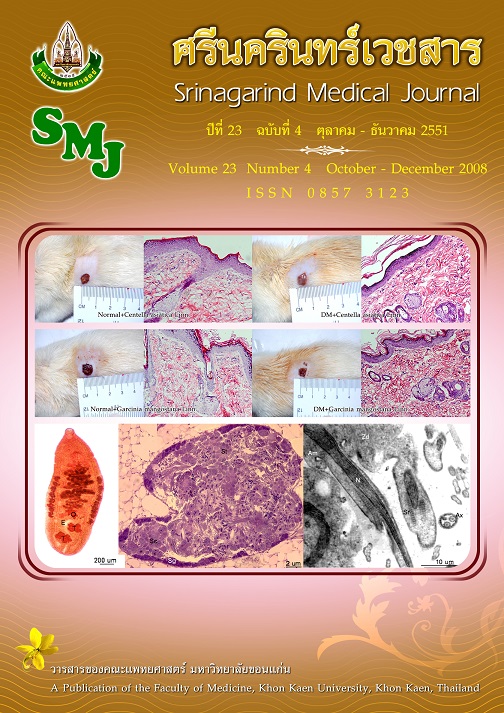The Reliability of Calcaneal Quantitative Ultrasound in the Measurement of Bone Mineral Density
Abstract
Background: Dual-energy X-ray absorptiometry (DXA) is regarded in other countries as the reference method for bone density assessment because of its high reliability and precision. It is an expensive and thus with limited availability in developing countries. Quantitative ultrasound (QUS) has been introduced as an alternative technology to bone densitometry. Advantages of this method for evaluating patients at risk of osteoporosis over X-ray-based techniques include its low cost, portability and no ionizing radiation. Until now, there has been no study in Thailand about the reliability of QUS for its use in diagnosis of osteoporosis.
Objectives: To study both the intra- and inter-observer reliability of stiffness index (SI) of QUS in measuring bone mineral density of the calcaneus
Study design: Cross-sectional descriptive study
Setting: Subject for bone density measurement were 100 Thai elderly women 60-89 years old (average age of 69.97 years), living in urban areas of Khon Kaen province, Thailand
Outcome measurement: Stiffness index (SI) of the calcaneus in elderly women measured by two observers twice each.
Results: This study was part of the study of “the combination of OSTA index and QUS in diagnosing osteoporosis”. The average weight of the subjects was 49.24 (30-81) Kg. The respective correlation coefficient (r) for SI between the 1st and 2nd measurements of the 1st and 2nd observers and between the 1st and 2nd observer was 0.973, 0.976 and 0.925 (p<0.001).
The limits of agreement for evaluating both intra- and inter-observer reliability for SI were used. The respective mean of the differences and the standard deviation (SD) between the 1st and 2nd measurements of the 1st and 2nd observers was 0.12 (SD=4) and 0.00 (SD=3.79). The respective mean of differences and the standard deviation (SD) between the measurements of the 1st and 2nd observers were -0.08 (SD=6.63). None of the comparisons significantly differed from zero, with a p-value of one sample t-test compare with zero (i.e., 0.765, 1, and 0.904 respectively).
Conclusion: The QUS is the reliable tool for measuring bone mineral density and it could be used as alternative for diagnosing osteoporosis, particularly in areas with limited access to, and resources for, DXA.
Keywords: QUS (Quantitative ultrasound), DXA (Dual Energy X-ray Absorptiometry), reliability, SI (stiffness index)



